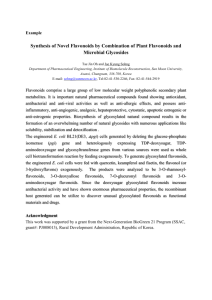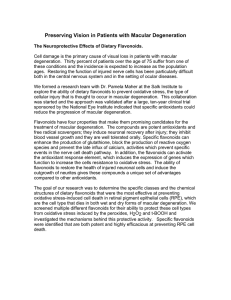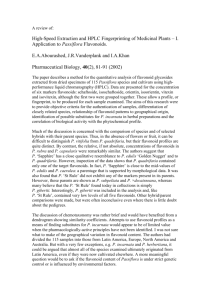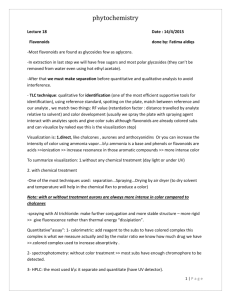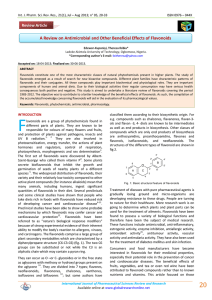Document 13308945
advertisement
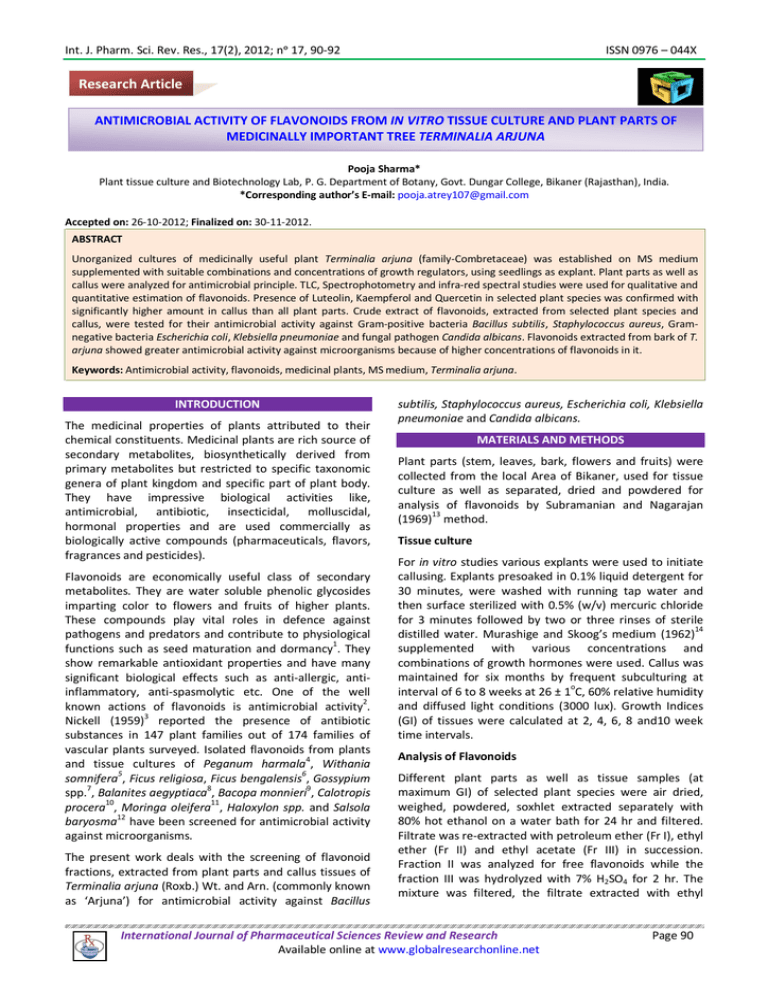
Int. J. Pharm. Sci. Rev. Res., 17(2), 2012; nᵒ 17, 90-92 ISSN 0976 – 044X Research Article ANTIMICROBIAL ACTIVITY OF FLAVONOIDS FROM IN VITRO TISSUE CULTURE AND PLANT PARTS OF MEDICINALLY IMPORTANT TREE TERMINALIA ARJUNA Pooja Sharma* Plant tissue culture and Biotechnology Lab, P. G. Department of Botany, Govt. Dungar College, Bikaner (Rajasthan), India. *Corresponding author’s E-mail: pooja.atrey107@gmail.com Accepted on: 26-10-2012; Finalized on: 30-11-2012. ABSTRACT Unorganized cultures of medicinally useful plant Terminalia arjuna (family-Combretaceae) was established on MS medium supplemented with suitable combinations and concentrations of growth regulators, using seedlings as explant. Plant parts as well as callus were analyzed for antimicrobial principle. TLC, Spectrophotometry and infra-red spectral studies were used for qualitative and quantitative estimation of flavonoids. Presence of Luteolin, Kaempferol and Quercetin in selected plant species was confirmed with significantly higher amount in callus than all plant parts. Crude extract of flavonoids, extracted from selected plant species and callus, were tested for their antimicrobial activity against Gram-positive bacteria Bacillus subtilis, Staphylococcus aureus, Gramnegative bacteria Escherichia coli, Klebsiella pneumoniae and fungal pathogen Candida albicans. Flavonoids extracted from bark of T. arjuna showed greater antimicrobial activity against microorganisms because of higher concentrations of flavonoids in it. Keywords: Antimicrobial activity, flavonoids, medicinal plants, MS medium, Terminalia arjuna. INTRODUCTION The medicinal properties of plants attributed to their chemical constituents. Medicinal plants are rich source of secondary metabolites, biosynthetically derived from primary metabolites but restricted to specific taxonomic genera of plant kingdom and specific part of plant body. They have impressive biological activities like, antimicrobial, antibiotic, insecticidal, molluscidal, hormonal properties and are used commercially as biologically active compounds (pharmaceuticals, flavors, fragrances and pesticides). Flavonoids are economically useful class of secondary metabolites. They are water soluble phenolic glycosides imparting color to flowers and fruits of higher plants. These compounds play vital roles in defence against pathogens and predators and contribute to physiological functions such as seed maturation and dormancy1. They show remarkable antioxidant properties and have many significant biological effects such as anti-allergic, antiinflammatory, anti-spasmolytic etc. One of the well known actions of flavonoids is antimicrobial activity2. Nickell (1959)3 reported the presence of antibiotic substances in 147 plant families out of 174 families of vascular plants surveyed. Isolated flavonoids from plants 4 and tissue cultures of Peganum harmala , Withania 5 6 somnifera , Ficus religiosa, Ficus bengalensis , Gossypium 7 8 9 spp. , Balanites aegyptiaca , Bacopa monnieri , Calotropis 10 11 procera , Moringa oleifera , Haloxylon spp. and Salsola baryosma12 have been screened for antimicrobial activity against microorganisms. The present work deals with the screening of flavonoid fractions, extracted from plant parts and callus tissues of Terminalia arjuna (Roxb.) Wt. and Arn. (commonly known as ‘Arjuna’) for antimicrobial activity against Bacillus subtilis, Staphylococcus aureus, Escherichia coli, Klebsiella pneumoniae and Candida albicans. MATERIALS AND METHODS Plant parts (stem, leaves, bark, flowers and fruits) were collected from the local Area of Bikaner, used for tissue culture as well as separated, dried and powdered for analysis of flavonoids by Subramanian and Nagarajan (1969)13 method. Tissue culture For in vitro studies various explants were used to initiate callusing. Explants presoaked in 0.1% liquid detergent for 30 minutes, were washed with running tap water and then surface sterilized with 0.5% (w/v) mercuric chloride for 3 minutes followed by two or three rinses of sterile distilled water. Murashige and Skoog’s medium (1962)14 supplemented with various concentrations and combinations of growth hormones were used. Callus was maintained for six months by frequent subculturing at interval of 6 to 8 weeks at 26 ± 1oC, 60% relative humidity and diffused light conditions (3000 lux). Growth Indices (GI) of tissues were calculated at 2, 4, 6, 8 and10 week time intervals. Analysis of Flavonoids Different plant parts as well as tissue samples (at maximum GI) of selected plant species were air dried, weighed, powdered, soxhlet extracted separately with 80% hot ethanol on a water bath for 24 hr and filtered. Filtrate was re-extracted with petroleum ether (Fr I), ethyl ether (Fr II) and ethyl acetate (Fr III) in succession. Fraction II was analyzed for free flavonoids while the fraction III was hydrolyzed with 7% H2SO4 for 2 hr. The mixture was filtered, the filtrate extracted with ethyl International Journal of Pharmaceutical Sciences Review and Research Available online at www.globalresearchonline.net Page 90 Int. J. Pharm. Sci. Rev. Res., 17(2), 2012; nᵒ 17, 90-92 Gram-positive bacteria Bacillus subtilis, Staphylococcus aureus, Gram-negative bacteria Escherichia coli, Klebsiella pneumoniae and fungal pathogen Candida albicans were selected for testing antimicrobial activity of flavonoids (antimicrobial principle). The growth medium used for bacteria was nutrient broth and Sabouraud’s liquid medium for Candida albicans. The inoculum was prepared by adjusting the concentration of microorganisms at 40% transmittance for bacteria and 65% for C. albicans using spectronic 20 calorimeter (Bausch and Lomb) set at 630 nm16. RESULTS AND DISCUSSION The explants first showed swellings at cut end within 4-5 days of inoculation and after one week the swollen portion bursted out to release undifferentiated callus mass. Callus was creamish and compact with fast multiplication up to eight weeks period. After that callus started becoming brownish black in tenth week which may be due to accumulation of secondary products in tissue. As the occurrence of secondary metabolites is very specific in plants and even in the plant parts, callus as well as all the plant parts was analyzed separately to estimate comparative amount of secondary metabolites. Comparing the amount of flavonoid in all plant parts, maximum amount of luteolin, kaempferol and quercetin and total flavonoid content has been estimated in bark. Amount of individual and total flavonoid content estimated was less in unorganized tissue than than bark and stem but higher than all remaining in vivo plant parts (Table - 1). Fruit In vivo Flower Testing of Flavonoids for Antimicrobial Activity Table 1: Flavonoids content (mg/100g.d.w.) in T. arjuna Leaves The isolates were identified by TLC (silica gel G coated plates) along with standard reference compounds – Apigenin, Isorhamnetin, Kaempferol, Luteolin, Scutellarein and Quercetin. The plates were developed in n-butanol, acetic acid and water (4:1:5 upper layer) and sprayed with 5% ethanolic FeCl3 solution. Each of the isolates was purified by preparative TLC in similar solvent system. Isolates were eluted with acetate, crystallized by CHCl3 and further confirmed by melting points, UV maxima on spectrophotometer and infra red spectral studies. Quantitative estimation of the identified flavonoids was carried out colorimetrically following 15 method of Kariyon et al., (1953) . Flavonoids identified by TLC, mp and UV spectra in T. arjuna was Luteolin, Kaempferol and Quercetin. Bark Identification of Flavonoids activity was reported against B. subtilis. Unorganized tissue had fewer amounts of flavonoids than maximum reported in bark, hence the zone of inhibition formed against B. subtilis was less than bark. Minimum activity of T. arjuna flavonoids was observed against fungal pathogen C. albicans while bark as well as callus did not show any activity against K. pneumoniae as zone of inhibition was not observed around their paper discs. This showed that antimicrobial principle against K. pneumoniae is inactive (Table - 2). Stem acetate was neutralized with 5% NaOH and then dried in vacuum and analyzed for bound flavonoids. ISSN 0976 – 044X In vitro Unorganized tissue Luteolin 0.56 0.59 0.41 0.49 0.45 0.48 Kaempferol 0.52 0.54 0.35 0.46 0.41 0.43 Quercetin 0.39 0.43 0.22 0.28 0.25 0.28 Total content 1.47 1.56 0.98 1.23 1.11 1.29 Flavonoids Values are mean of five replicates ± SD Table 2: Antimicrobial activity of crude extract of flavonoids of T. arjuna Crude extract Gram+ve bacteria Gram-ve bacteria Fungal pathogen BS SA EC KP CA Bark 7.6 7.3 6.9 - 6.5 Callus 7.2 7.0 6.5 - 6.2 Value represent diameter of zone of inhibition in mm including diameter of paper disc (6mm). Experiment was repeated five times. The values represent the average diameter. SA = Staphylococcus aureus, EC = Escherichia coli, BS = Bacillus subtilis, KP = Klebsiella pneumonia, CA = Candida albicans. CONCLUSION It can be concluded by all above reports that the flavonoids present in plants are working as active principles to show the antimicrobial activity against many Gram +ve and Gram -ve bacteria as well as fungal pathogen. Thus the studied plant is potentially a good source of antimicrobial agents and validates their traditional medicinal use and as a source for natural antibacterial that can serve as an alternative to more expensive conventional medicines and a basis for further pharmacological evaluation. Acknowledgement: I would like to express my deep and sincere gratitude to my research supervisor, Dr. (Mrs.) Asha Goswami, Head, Department of Botany, Govt. Dungar College, Bikaner for giving me the opportunity to do research and providing invaluable guidance throughout this research. Flavonoids isolated from bark and callus was tested for antimicrobial activity against Bacillus subtilis, Staphylococcus aureus, Escherichia coli, Klebsiella pneumoniae and Candida albicans. Antimicrobial test against five microorganisms showed that maximum International Journal of Pharmaceutical Sciences Review and Research Available online at www.globalresearchonline.net Page 91 Int. J. Pharm. Sci. Rev. Res., 17(2), 2012; nᵒ 17, 90-92 ISSN 0976 – 044X 9. REFERENCES Alam, K, Parvez, N, Yadav, S, Molvi, K, Hwisa, N, Sharif, SMAl, Pathak, D, Murti, Y and Zafar, R, Antimicrobial activity of leaf callus of Bacopa monnieri L. Der Pharmacia Lettre. 3(1), 2011, 287-291. 1. Brenda, WS, Flavonoids in seeds and grains: physiological function, agronomic important and the genetics of biosynthesis. Seed Science Research, 8, 1998, 415-422. 2. Skinner, FA, Antibiotics. In:modern methods of Plant Analysis. Peach, K. and Tracey, M. V. (Eds). Spinger-Verlag, Berlin, 3, 1955, 626-725. 3. Nickell, LG, Antimicrobial activity of vascular plants. Econ. Bot., 13, 1959, 281-318. 11. Talreja, T, Yadav, L, Sharma, K and Goswami A, Flavonoids from some medicinal plants in vivo and in vitro. The Bioscan, 7(1), 2012, 157-159. 4. Badia, N, Influence of plant growth regulators and precursors on the production of primary and secondary metabolites in tissue culture of Peganum harmala Linn. Ph.D. Thesis MDS University, Ajmer, Rajasthan, India, 1999. 12. Kaur, P and Bains NS, Antimicrobial activity of flavonoids from in vitro tissue culture and plant parts of important halophytes of Western Rajasthan, Current Biotica 6(1), 2012, 1-7. 5. Bains, NS, Production of primary and secondary metabolites in Calligonum and Withania species grown in vivo and in vitro. Ph.D. Thesis MDS University, Ajmer, Rajasthan, India, 2002. 13. Subramanian, SS and Nagarajan, S, Flavonoids of the seeds of Crotalaria retusa and C. striata. Curr. Sci. 38, 1969, 6568. 6. Uma, B, Prabhakar, K and Rajendran, S, In vitro antimicrobial activity and phytochemical analysis of Ficus religiosa and Ficus bengalensis against diarrhoeal enterotoxigenic E. coli. Ethnobotanical, 13, 2009, 472-74. 7. 8. Chaturvedi, A, Singh, S and Nag, TN, Antimicrobial activity of flavonoids from in vitro tissue culture and seeds of Gossypium species. Romanian Biotechnological letters. 15(1), 2010, 4960-4963. Bedawat, S, Nag, R and Nag, TN, Antimicrobial principales from tissue cultures of Balanites aegyptiaca. Romanian Biotechnological letters. 16(2), 2011, 6120-6124. 10. Swapnali MG, patil, MV and Mahajan, RT, Phytochemical screening and antimicrobial activity of ethanol extract of Calotropis procera root. IJRPP, 2(3), 2012, 143-146. 14. Murashige, T and Skoog, F, A revised medium for rapid growth and bioassays with tobacco tissue cultures. Physiol. Plantarum. 15, 1962, 473-497. 15. Kariyon, T, Hashimoto, Y and Kimura, M, Microbial studies of plant components. IX. Distribution of flavonoids in plants by paper chromatography. J. Pharma. Soc. (Japan). 73, 1953, 253-256. 16. Khanna, P and Staba, EJ, Antimicrobial from plant tissue cultures. Lloydia 31, 1968, 180-190. *********************** International Journal of Pharmaceutical Sciences Review and Research Available online at www.globalresearchonline.net Page 92
